A perennial plant is one that lives two or more years. By definition, herbaceous perennials are nonwoody plants whose above-ground parts usually die to the ground each year. They survive winter weather by means of a vigorous root system, bulbs, corms, tubers, rhizomes or other underground root or stem modifications. Several shrubs that often die back to the ground each year are frequently grouped with herbaceous perennials even though they are technically woody plants. Roses, tree peonies and Russian sage are examples of flowering shrubs more frequently considered flowering perennials. Even though they are woody plants, they regrow vigorously each year from the root system if harsh winter weather causes a complete dieback.
Herbaceous perennials can be further subdivided into hardy and tender plants, based on the plant's ability to survive the winter. Examples of hardy perennials are tulips, lilies, daylilies, peonies and irises. Tender perennials include dahlias, gladioluses and cannas. While it may seem a misnomer to classify a nonhardy plant as a perennial, the presence of a storage organ (e.g., a corm or tuber) puts a plant into the herbaceous perennial category.
Herbaceous perennials are considered the backbone of most flower gardens. Plants provide almost year-round interest with a variety of flower color, form, foliage, texture and fragrance. Careful planning can ensure a succession of bloom that provides a changing kaleidoscope of color through the seasons.

Figure 1. Because perennials are less formal than annuals, they often are used in border plantings such as the one pictured above.
The pages of this guide list some major perennial plants and their important characteristics and cultural preferences.
Space is not available here to fully describe the plants and flowers. Reviewing garden websites or visiting a nursery, garden center or botanic garden will help you become familiar with available plants.
Characteristics and culture of flowering perennials
| Common name, Scientific name |
Height (inches) |
Bloom period |
Color | Light | Moisture | Soil | Relative ease |
Remarks |
|---|---|---|---|---|---|---|---|---|
| Anemone, Japanese (Anemone japonica) |
18–30 | Sept.–frost | W, P | SS | WD | L | M | Dislikes transplanting. Spring plant only. |
| Anthemis, Golden Marguerite (Anthemis tinctoria) |
12–24 | Aug.–frost | Y | FS | WD | L | M | Attractive fine-cut leaves. Divide every 3 to 4 years. Self-seeds readily. |
| Artemisia (Artemisia sp.) |
9–36 | Aug.–Sept. | W, Y | FS | WD | SL | E | Many species and varieties, including Silver Mound and Silver King. |
| Aster, Michaelmas daisy (Aster hybrids) |
12–72 | July–frost | W, R, B, L, V, P | FS | M, WD | L | M | Many varieties of differing growth habit. Divide every other year. |
| Astilbe (Astilbe sp.) |
12–24 | May–June | W, P | FS | M, WD | L | E | Easy to grow. Good companion plant to hosta. |
| Baby’s breath (Gypsophila paniculata) |
18–30 | June–July | W, P | FS | WD | L | E | Easy to grow. Avoid acid soil. Add lime if necessary. |
| Balloon flower (Platycodon grandiflorum) |
18–24 | May–Aug. | B, W, P | FS | WD | S | M | Weak-stemmed plant, may need staking. Avoid wet soil. |
| Basket-of-gold (Aurinia saxatile) |
12–18 | May | Y | FS | WD | S | M | Gray foliage. Suitable for rock garden. |
| Beardtongue (Penstemon sp.) |
6–28 | June–July | P, R, L | FS | WD | S | M | Avoid acid soil. Fairly short-lived. Some good as cut flower. |
| Bee-balm (Monarda didyma) |
18–24 | July–Aug. | R, P, L, W | FS | WD, D | L | M | Useful for hot, dry places. Also endures light shade. |
| Bellflower (Campanula sp.) |
8–36 | May–July | W, B | FS, SS | WD | SL | M | Needs good drainage. Avoid clay. Mulch in winter. Species vary in height. |
| Bergenia (Bergenia cordifolia) |
12–15 | May–June | P, W | SS | M | L | M | Waxy foliage remains green in winter. |
| Blackberry lily (Belamcanda chinensis) |
24–36 | July–Aug. | O | FS | WD | L | E | Flowers followed by blackberry-like seed pods. |
| Black-eyed Susan (Rudbeckia fulgida) |
24–36 | June–July | Y, O | FS | WD | L | E | Very heat tolerant. Good for bold splash of color. |
| Bleeding heart, Old-fashioned (Dicentra spectabilis) |
18–24 | May | P, R | FS, SS | WD | L | M | Best in part shade. Leaves may die-back in summer. |
| Blue false indigo, Rattle weed (Baptisia australis) |
36–48 | May–June | B | FS | WD | SL | E | Forms dark pods with large seeds that rattle. |
| Blue flax (Linum perenne) |
12–28 | June–Aug. | B | FS | WD | L | E | Short-lived. Easily grown from seeds planted in spring. |
| Boltonia (Boltonia asteroids) |
24–48 | Aug.–Sept. | W, P | FS | WD | L | E | Choose named cultivars. Species gets too tall for most gardens. |
| Brunnera, Siberian bugloss (Brunnera macrophylla) |
12–18 | May–June | B | SS | M, WD | L | M | Flowers resemble forget-me-not. |
| Butterfly weed (Asclepias tuberosa) |
12–20 | Aug. | O, Y, R | FS | WD | SL | E | Difficult to transplant. Suited to hot, dry sites. Attracts monarch butterfly. |
| Candytuft (Iberis sempervirens) |
8–12 | April | W | FS | WD | L | M | For rock garden and stone walls. |
| Chrysanthemum (Chrysanthemum x morifolium) |
10–36 | July–frost | W, R, O, V, L, P | FS | WD | L | E | Variety determines growth habit. Pinch tips of tall types in early summer to promote bushiness. |
| Columbine (Aquilegia hybrid) |
6–36 | April–June | W, R, P, V, B, L, Y | FS, SS | WD | SL | E | Fairly short-lived. Reseeds easily. Sow seeds in early summer. |
| Coneflower, Purple (Echinacea purpurea) |
24–36 | Aug.–Oct. | P | FS | WD | L | E | Tolerates very poor soil. Heat and drought tolerant. |
| Coral bells (Heuchera sanguinea) |
18–24 | June | W, P, R | FS, SS | WD | L | M | Divide every 3 years. Good cut flower. |
| Coreopsis, Thread-leaf tickseed (Coreopsis verticillata) |
18–30 | June–Aug. | Y | FS, SS | WD, M | L | E | Easy to grow. Blends well with other perennials. Blooms all summer. |
| Daylily (Hemerocallis hybrids) |
15–36 | June–Sept. | R, O, Y, L, P | FS, SS | WD, M, D | L | E | Easily grown. Adapts to many conditions. Excellent hybrids available. |
| Delphinium (Delphinium elatum) |
36–60 | July–Aug. | W, B, L | SS | WD | L | M | Likes cool weather. Give afternoon shade. Needs excellent drainage. |
| Evening primrose (Oenothera sp.) |
8–36 | July–Aug. | Y, P | FS | WD | SL | M | Flowers open in evenings. Good rock garden plant. Some can be invasive. |
| False dragonhead (Physostegia virginiana) |
18–48 | July–Sept. | P, W | FS, SS | M, WD | L | E | Also called obedient plant. Very vigorous grower. |
| False sunflower (Heliopsis helianthoides) |
36 | July–Sept. | Y, O | FS | WD | L | M | Flowers good for cutting. |
| Foamflower (Tiarella cordifolia) |
10–12 | May–June | W, P | SS, S | WD | L | M | Compact, spreading growth habit. Flowers similar to Astilbe. |
| Foxglove (Digitalis purpurea) |
24–28 | June | V, P, W | SS | M, WD | L | M | Grow as biennial. Prefers cool temperatures. |
| Gaillardia (Gaillardia x grandiflora) |
24–30 | July–Sept. | Y, R | FS | WD | L | M | Easy to grow. Heat tolerant. |
| Geum, Avens (Geum hybrids) |
12–20 | July | R, O, Y | FS | WD | SL | M | Divide every 3 years. Provide winter mulch. |
| Globe thistle (Echinops ritro) |
24–48 | July–Sept. | B | FS, SS | WD | SL | E | Tolerates poor soil. Replant every 3 to 4 years. |
| Globeflower (Trollius europaeus) |
12–18 | May | Y, O | FS, SS | M, WD | L | M | Do not let dry out. Good beside pools. |
| Gooseneck loosestrife (Lysimachia clethroides) |
24–36 | July–Aug. | W | FS | WD | L | E | Very aggressive. May become invasive. |
| Helenium, Sneezeweed (Helenium autumnale) |
36–48 | Aug.–Oct. | Y, R | FS | M, WD | L | E | Good cut flower. Divide and replant every 3 years. |
| Hibiscus, hardy (Hibiscus palustris) |
24–60 | July–Sept. | W,P, R | FS | M, WD | L | M | Very large flowers. Tolerates damp soil. |
| Hollyhock (Alcea rosea) |
48–72 | July–Aug. | W,P, R | FS | WD | L | E | Grown as biennial. Seed outdoors in July. |
| Hosta, Plantain lily (Hosta sp.) |
6–36 | July–Aug. | W, L | SS, S | M, WD | L | E | Excellent for shady areas. Many have variegated leaves. |
| Iris, Bearded, German iris (Iris x germanica) |
12–36 | April–June | B, V, R, P, W, Y, L, O | FS | WD | L | E | Easy to grow. Many varieties available. Very dependable and easy to grow. |
| Iris, Japanese (Iris ensata) |
18–36 | June–July | B, W, Y, L, P | FS, SS | M, WD | L | M | Needs moist soil. Suitable at the edge of ponds. |
| Iris, Siberian (Iris siberica) |
18–24 | May–June | W, B | FS, SS | M, WD | L | E | Likes rich soil. Never let dry out. |
| Lamb’s ears (Stachys byzantina) |
12–18 | June | P | FS, SS | WD | SL | M | Will grow in dry, poor soils. Woolly grayish leaves. |
| Lady’s mantle (Alchemilla mollis) |
10–12 | June–July | Y | FS, SS | M | L | M | Compact, spreading habit. Prefers a cool, moist location. |
| Lavender (Lavendula angustifolia) |
12–20 | July–Aug. | L | FS | WD | SL | M | Needs well-drained soil. Very fragrant foliage. |
| Leadwort (Ceratostigma plumbaginoides) |
8–12 | Aug.–frost | B | FS | WD | SL | E | Sometimes called plumbago. Semiwoody groundcover. |
| Lenten rose (Helleborus niger) |
5–8 | Feb.–March | W | SS | M, WD | L | C | Needs rich soil. Do not disturn root system. |
| Liatris, Gayfeather (Liatris sp.) |
24–48 | July–Sept. | W, L | FS | WD | SL | E | Adapts well to dry locations. Spike florets mature from top downward. |
| Lily turf (Liriope muscari) |
6–10 | Aug. | V, W | FS, SS, S | WD | L | E | Evergreen border plant. Forms clumps. Cut back old growth in early spring. |
| Lily-of-the-valley (Convallaria majalis) |
6–8 | May | W, P | SS | M, WD | L | E | Needs shade. Used as a groundcover or cut flower. |
| Loosestrife, yellow (Lysimachia punctata) |
18–30 | July–Sept. | Y | FS, SS | M, W | L | E | Needs semi-shade in dry soils. Can be invasive. |
| Lungwort (Pulmonaria sp.) |
8–12 | May–June | B | SS, S | M | L | M | Very distinctive foliage with unusual variegation. |
| Lupine (Lupinus hybrids) |
24–40 | June–July | B, W, P, Y | FS, SS | WD | SL | C | Dislike hot summers. Short-lived in Midwest. |
| Meadow rue (Thalictrum aquilegifolium) |
24–30 | June–July | P, V, W | FS, SS | M, WD | L | M | Needs afternoon shade. Prized for foliage and flowers. |
| Meadow sweet (Filipendula vulgaris) |
24–36 | June–July | W, P | FS, SS | WD | L | E | Fleecy, graceful flowers. Prefers humus-enriched soil. |
| Painted daisy, Pyrethrum (Tanacetum coccineum) |
12–24 | June–July | P, R, W | FS | WD | L | C | Will not tolerate wet soils. Prefers cool temperatures. |
| Pasque flower (Pulsatilla vulgaris) |
6–10 | April | B, W | FS | WD | SL | M | For rock garden. Needs good drainage. Blooms early. |
| Peony (Paeonia hybrids) |
18–36 | May–June | W, P, R | FS, SS | WD | L | E | Very long-lived. Huge, elegant flowers. |
| Perennial salvia (Salvia x superba) |
18–24 | June–July | B, V, P | FS | WD | L | E | Effective blue flower color. Attracts bees. |
| Phlox, Creeping (Phlox subulata) |
3–5 | April–May | P, L, W | FS | WD | SL | M | Also called ground pink or thrift. Tolerates poor soil. |
| Phlox, Garden (Phlox paniculata) |
18–48 | June–Sept. | R, P, L, W | FS, SS | WD | L | M | Many varieties available. Blooms mid-summer. |
| Pincushion flower (Scabiosa caucasica) |
18–24 | June–July | B | FS | WD | L | M | Unique blue flower with conspicuous stamens. |
| Pink, Cottage (Dianthus plumarius) |
10–15 | May–July | R, W, P | FS | WD | L | M | Very fragrant. Bluish gray foliage. Edging plant. |
| Pink, Maiden (Dianthus deltoides) |
4–9 | May | R, P, W | FS | WD | L | M | Dwarf pink. Gradually spreads to form a green mat. |
| Poppy, Iceland (Papaver nudicaule) |
8–12 | June | R, O, P, W | FS, SS | WD | SL | M | Often grown as annual. Seeds started indoors will flower first season. |
| Poppy, Oriental (Papaver orientalis) |
24–40 | May–July | O, R, P, W | FS | WD | SL | E | Needs good drainage. Place in protected spot, or mulch in winter. |
| Red-hot poker, Tritoma (Kniphofia hybrids) |
36–48 | July–Sept. | O, Y, P, W | FS | WD | SL | E | Needs excellent drainage. Mulch in winter. |
| Rock soapwort (Saponaria ocymoides) |
5–10 | June–July | P, W | FS | WD | SL | M | Pruning back helps retain compact form. Needs good drainage. |
| Russian sage (Perovskia atriplicifolia) |
36–48 | June–July | B | FS | WD | L | E | Uniquely colored, aromatic foliage. Light blue flowers that attract bees. |
| Sea lavender (Limonium latifolium) |
15–24 | Aug.–Sept. | B, W | FS | WD | SL | M | Large foliage. Delicate blue flowers on large panicles. |
| Sedum, Stonecrop (Sedum sp.) |
4–24 | June–frost | P, R, Y, W | FS | WD | SL | E | Very heat and drought tolerant. Many species with varying heights. |
| Shasta daisy (Leucanthemum x superbum) |
12–36 | June–Aug. | W, Y | FS | WD | L | M | Somewhat short-lived in garden. Dwarf and tall forms available. |
| Snow-in-summer (Cerastium tomentosum) |
3–5 | May–June | W | FS | WD | SL | M | Small gray woolly leaves. Forms dense carpet. Needs excellent drainage. |
| Spiderwort (Tradescantia virginiana) |
8–24 | May–Aug. | B, V, W | SS, S | M, WD | L | E | Easily grown. Bright blue flowers. Native plant. |
| Stoke’s aster (Stokesia laevis) |
12–30 | Aug.–Sept. | B, W, P | FS | WD | L | M | Needs good drainage. Mulch in winter. |
| Sweet pea, Perennial (Lathyrus latifolius) |
60–96 | June–Aug. | P, R, W | FS, SS | M, WD, D | L | E | Very easy to grow. May crowd out other plants. |
| Sweet William (Dianthus barbatus) |
6–15 | May–June | R, P, W | FS | WD | L | E | Biennial that self-sows easily. An “old-fashioned” favorite. |
| Thrift (Armeria maritima) |
8–12 | June–July | P, V, W | FS | WD | SL | E | Needs good drainage. Mulch in winter. |
| Tickseed (Coreopsis grandiflora) |
24–36 | June–July | Y, O | FS | WD | L | E | Tolerant of dry soils. Good for low maintenance areas. |
| Veronica, Speedwell (Veronica sp.) |
2–36 | May–Sept. | B, W | FS | WD | L | E | Easy to grow. Species differ in growth habit. |
| Violet, sweet (Viola adorata) |
6–8 | April–May | V, L, W, Y | FS, SS | WD, M | L | E | Forms a dense mat. Reseeds easily. Can be invasive. |
| Yarrow, Sneezewort (Achillea sp.) |
2–36 | June–Aug. | Y, P, R, W | FS | WD | L | E | Easy to grow. Delicate aromatic foliage. |
| Yucca (Yucca filamentosa) |
20–30 | June–July | W | FS | WD | L | E | Very durable. Bears huge spike with white flowers. |
Description of terms and codes
Height
The height range, given in inches, helps to determine whether a plant is suitable for an edging (1–12 inches), for the middle of a bed (12–36 inches), or for a background plant (more than 36 inches). Where a very wide range is given (such as Bellflower, 8–36 inches), some dwarf varieties are indicated.
Bloom period
The month or months of peak bloom are listed. Time of flowering varies with exposure and climatic area. These listings are primarily for central Missouri.
Color(s)
Plants are keyed with their most common colors. Many blends, shades and tints exist.
- Blue (B)
- Green (G)
- Lavender (L)
- Orange (O)
- Pink (P)
- Red (R)
- Violet (V)
- White (W)
- Yellow (Y)
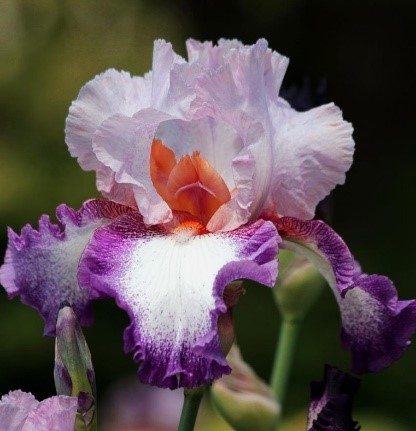 Bearded iris.
Bearded iris.
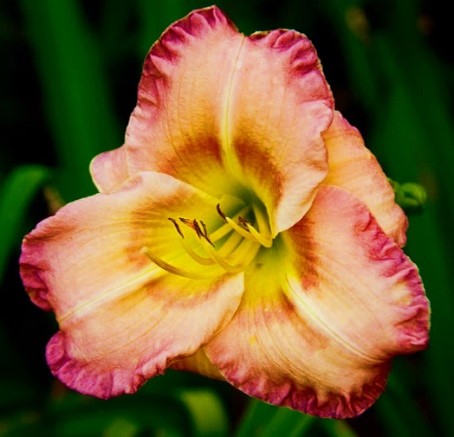 Daylily.
Daylily.
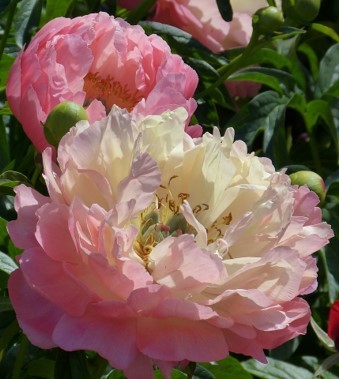 Peony.
Peony.
Cultural requirements
Light
- Full sun (FS)
Locate plant away from the shade of buildings, large trees or other objects that will not allow at least six hours of direct sunlight each day. - Semi-shade (SS)
Give partial shade either as a long period of light shade or as more dense shade during the afternoon. Most plants in this category must have shade during the hottest part of the day. - Shade (S)
These plants must have continuous shade with no direct sun. In heavy shade, other necessary cultural requirements must be carefully fulfilled.
Moisture
- Well drained (WD)
Periods of standing water on the soil are damaging to perennials in both summer and winter. In heavy soils, add liberal amounts of organic matter to ensure good internal soil drainage. If external drainage is poor, consider raised beds or drain tile below. For information on improving soils, see MU Extension publication G6955, Improving Lawn and Landscape Soils. - Dry (D)
These plants will not tolerate moist conditions very long, but they will withstand considerable dryness. - Moist, but well drained (M)
Plants in this category do not tolerate drying, but they also do not tolerate any water standing around their roots. In the garden, they need regular watering during dry periods. - Wet (W)
Plants will tolerate boggy conditions or even standing water. However, they are not the aquatics, such as waterlilies. Aquatic plants are not included in this publication.
Soil
- Loam (L)
Any good well-kept garden soil fits this category. Yearly additions of organic matter help develop a good loam. Where a poor soil is to be planted for the first time, amend it by mixing in at least 4 inches of organic matter. - Sandy loam (SL)
This type of soil is required mainly by plants that need excellent drainage. If the original soil is a tight clay, large amounts of sand will have to be added to achieve this type of soil.
Relative ease of care
- Easy (E)
- Moderate (M)
- Challenging (C)
Remarks
Unusual or outstanding plant and cultural characteristics are listed briefly. Included are notes on cultural ease, winter hardiness, or special uses, or emphasis of an extremely important cultural requirement.
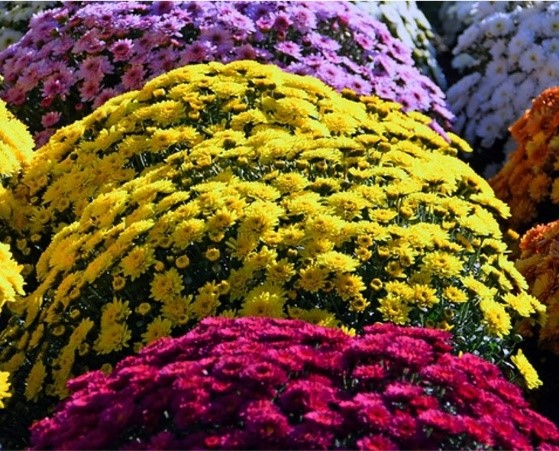 Garden chrysanthemum.
Garden chrysanthemum. 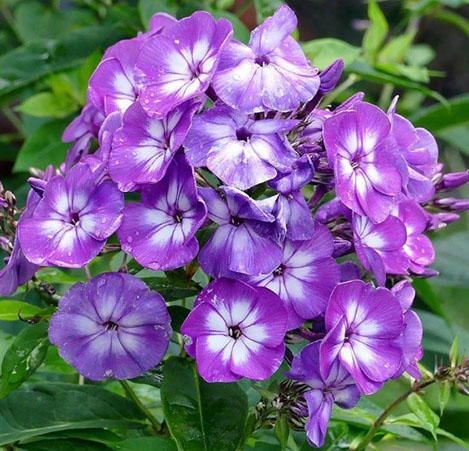 Garden phlox.
Garden phlox.